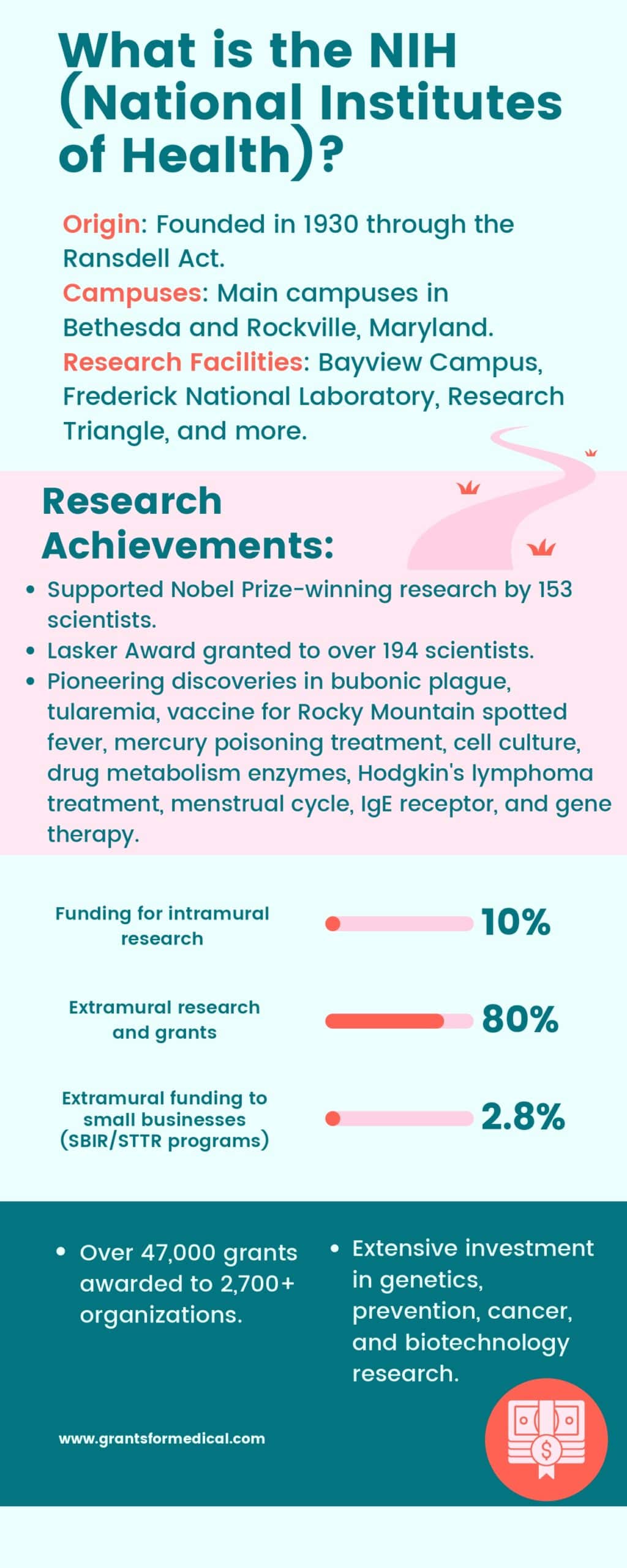What is the NIH (National Institutes of Health)? – Overview
The National Institutes of Health, NIH for short, is the leading agency of the US Federal government. It is aimed at research into public health and biomedical advances.
Let’s take a quick look at some of the important aspects of the NIH.
Origin of National Institutes of Health (NIH)
In 1930, the Ransdell Act renamed the Hygienic Laboratory to the National Institute of Health.
Hygienic Laboratories, part of the Marine Hospital Service, was renamed NIH. In 1937, the NIH took over the remaining Division of Scientific Research, earlier its part.
The Division of Scientific Research was formed in 1901 and included the Hygienic Laboratories and other research offices, which were part of the Marine Hospital Service.
The NIH moved to its Bethesda, Maryland, campus in 1938.
Over the next 20 years, Congress began increasing funding to the NIH and other similar institutes created within the NIH for specific research programs. 1948 the name was changed to the National Institutes of Health.
As of 1991, the NIH budget comprised nearly 1% of the U.S. federal budget and provided the majority of public funding for biomedical research in the U.S., including a significant proportion of research funding in universities.
Between 1990 and the late-2000s, government funding for NIH grew exponentially and more than tripled.
NIH Campuses and Locations
The NIH conducts intramural research at its main campuses, including Bethesda, Maryland, Rockville, Maryland, and adjacent communities.
- The Bayview Campus in Baltimore, Maryland, hosts the National Institute on Drug Abuse research programs, the National Institute on Aging, and the National Human Genome Research Institute. This campus supports around 1,000 research scientists and staff.
- The Frederick National Laboratory, located in Frederick, Maryland, and the adjacent Riverside Research Park are hosts to various parts of the National Cancer Institute, which also includes the Center for Cancer Research, Management Operations Support Branch, Office of Scientific Operations, the division of Cancer Treatment and Diagnosis and the division of Cancer Epidemiology and Genetics.
- The National Institute of Environmental Health Sciences is based out of the famous Research Triangle region in North Carolina.
- The National Institute of Allergy and Infectious Diseases office is located in Rocky Mountain Labs, which is based in Hamilton, Montana. This campus mainly conducts BSL3 and BSL4 laboratory work.
- The Phoenix Epidemiology and Clinical Research Branch, operated by the NIDDK, is in Phoenix, Arizona.
Research Achievements

Since its inception, the National Institutes of Health has supported research by numerous scientists. As of a recent count, 155 NIH-supported researchers have received Nobel Prizes, and 218 have received Lasker Awards.
Let’s take a closer look at some of the most essential research studies supported by the NIH:
The NIH allocates around 10% of its total budget to intramural research. About 80% of its budget is allocated to extramural research through grants.
Around 2.8% of extramural research funding is granted to small businesses, as per SBIR/STTR programs.
In 2011, extramural funding consisted of around 50,000 individual grants and was offered to more than 35,000 researchers from more than 3,000 separate institutions.
In 2018, the NIH issued nearly 50,000 grants to over 300,000 researchers at more than 2,500 institutions.
The institute has spent billions on genetics, prevention, cancer, and biotechnology-related research.
What is the NIH? Notable NIH Achievements
Since its founding, the NIH intramural research program has been pivotal in numerous scientific and medical breakthroughs, such as:
- George W. McCoy discovered rodents to be carriers of bubonic plague in 1908.
- Charles W. Chapin, George W. McCoy, William B. Wherry, and B. H. Lamb described the previously unknown tularemia in 1911.
- Ralph R. Parker and Roscoe E. Spencer developed a vaccine against the Rocky Mountain spotted fever in 1924.
- Sanford M. Rosenthal developed a treatment for mercury poisoning, which was the main treatment before the discovery of mercaptoethanol in 1930.
- Wilton R. Earle created the first cell culture process and published a paper in 1943 describing the production of malignancy in vitro.
- Julius Axelrod discovered cytochrome P450 monooxygenases, a new class of enzyme for drug metabolism, in 1950.
- Developed an effective combination drug treatment for Hodgkin’s lymphoma in the 1960s.
- Described the hormonal cycle accurately during menstruation in 1970.
- Discovered the accurate structure of the lgE receptor involved in allergic reactions 1980.
- Conducted the first trial of gene therapy in humans in the 1990s.
Conclusion
The National Institutes of Health (NIH) has achieved its objective of promoting research into healthcare and biotechnology over the past years.
It has helped thousands of institutes and researchers discover aspects of illnesses and innovative treatment methods for numerous ailments and disorders.
The NIH remains the primary aim of funding for thousands of researchers in the United States today.
See Also
Does Medicare Cover Hearing Aids?
Does Medicare Cover Dental Implants?